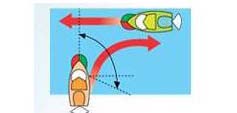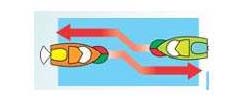
Rules of Navigation on Harvey’s Lake
As of January 1, 2006, the boating laws in the State of PA have changed. There is no longer a requirement to travel in a COUNTERCLOCKWISE direction on PA waters. If you have noticed, boating traffic on the lake now has some folks continuing in a counterclockwise manner and others traveling in other directions. Now, it is more important than ever to understand the basic U.S. Coast Guard rules of navigation which still apply. Here’s a brief summary of some of those rules:
MAINTAIN A PROPER LOOKOUT - Boat operators must maintain a proper lookout at all times when operating a boat. Collisions and other types of accidents can be avoided by scanning all around the boat for swimmers, other boats and obstructions. Listening for dangerous situations is also a part of maintaining a proper lookout. Passengers should be asked to assist.
OPERATE AT A SAFE SPEED - A boater’s speed of operation will vary according to the weather, water conditions, time of day or night, other boat traffic and individual boat characteristics. Safe speed allows the operator to be in control and take corrective action to avoid a collision. Harveys Lake also has two special regulations regarding speed. At night, from sunset to sunrise, all boats must operate at slow-no-wake speed. And during the summer, on weekends and holidays, there is a 45MPH daytime speed limit.
CROSSING SITUATIONS - All boats have a danger zone from dead ahead (12 o’clock) to starboard (the right side) 112.5 degrees (4 o’clock). In a crossing situation, the boat in the danger zone (ahead and to the right) is the stand-on vessel. It must maintain course and speed. The give-way vessel must stop or slow down and let the stand-on vessel continue on. If space permits, the give-way vessel can bear off to starboard and pass behind the stand-on vessel. If the give-way vessel does not take the required action, then the stand-on vessel operator must be prepared to take action to avoid collision.

HEAD-ON (MEETING) SITUATIONS - When two boats meet head-on, both vessels are give-way vessels. Both boats are required to turn to starboard (to the right), to avoid the other, and pass port to port (left side to left side).

OVERTAKING SITUATIONS - The boat being passed is the stand-on vessel. It must maintain course and speed while the overtaking (give-way) vessel passes by. The overtaking vessel is always the give-way vessel and may pass on either side.
